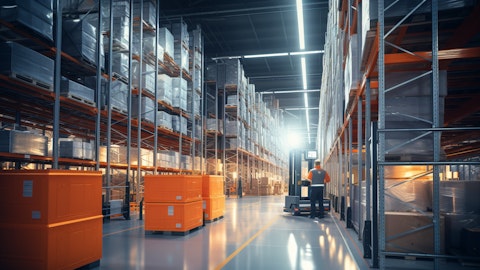Stabilis Solutions, Inc. (NASDAQ:SLNG) Q3 2025 Earnings Call Transcript November 7, 2025
Operator: Good morning, everyone, and welcome to the Stabilis Solutions’ Third Quarter 2025 Earnings Conference Call. [Operator Instructions] Now at this time, I would like to turn the conference over to Mr. Andy Puhala, Chief Financial Officer. Mr. Puhala, please go ahead, sir.
Andrew Puhala: Good morning, and welcome to Stabilis Solutions’ Third Quarter 2025 Results Conference Call. I’m Andy Puhala, Senior Vice President and CFO of Stabilis, and joining me today is our Executive Chairman and Interim President and CEO, Casey Crenshaw. We issued a press release after the market closed yesterday detailing our third quarter operational and financial results. This release is publicly available in the Investor Relations section of our corporate website at stabilis-solutions.com. Before we begin, I’d like to remind everyone that today’s conference call will contain forward-looking statements within the meaning of the Private Securities Reform Act of 1995 and other securities laws. These forward-looking statements are based on the company’s expectations and beliefs as of today, November 6, 2025.

Forward-looking statements are subject to risks and uncertainties that may cause actual results to differ materially from those projected. The company undertakes no obligation to provide updates or revisions to the forward-looking statements made in today’s call. Additional information concerning factors that could cause those differences is contained in our filings with the SEC and in the press release announcing our results. Investors are cautioned not to place undue reliance on any forward-looking statements. Further, please note that we may refer to certain non-GAAP financial information on today’s call. You can find reconciliations of the non-GAAP financial measures to the most comparable GAAP measures in our earnings press release. Today’s call is being recorded and will be available for replay.
With that, I’ll hand the call over to Casey Crenshaw for his remarks.
J. Crenshaw: Thank you, Andy, and good morning to everyone joining us on the call. We executed according to plan in the third quarter, capitalizing on continued demand for our integrated last-mile LNG solutions across our markets. Third quarter volume increased by more than 20% year-over-year, driven by strong demand across our growing base of marine, aerospace and power generation customers. We continue to see healthy demand trends across these sectors, supported by increased commercial space flight activity, seasonally strong demand for distributed power and robust throughput from cruise activity in the late summer months. Commercially, our team remains highly engaged with both new and existing customers, particularly in the aerospace and marine markets.
Q&A Session
Follow Stabilis Solutions Inc. (NASDAQ:SLNG)
Follow Stabilis Solutions Inc. (NASDAQ:SLNG)
Receive real-time insider trading and news alerts
We also see growing opportunity in the power generation as domestic investment in new data center capacity increases the need for on-demand distributed power solutions. As announced in October, we secured the largest customer contract in the company’s history, a 10-year marine bunkering contract for LNG, produced at our proposed 350,000 gallon per day LNG facility in Galveston, Texas. Subject to the finalization of project financing, we expect to break ground on the Galveston facility in the first quarter of 2026 and are targeting the facility to come on stream in late 2027. In parallel, we plan to construct a Jones Act compliant LNG bunkering vessel to serve customers in the Port of Galveston, Houston Ship Channel, and surrounding areas, consistent with a focus on building a vertically integrated marine bunkering solution in the local market, and this will serve as a template for what we seek to replicate in additional markets over time.
Beyond this initial bunkering customer, who will represent approximately 40% of the planned offtake capacity at the Galveston facility, we’re in late-stage negotiations with another marine bunkering customer for an additional 20% of our planned production capacity. We expect to have approximately 75% of the total capacity sold under long-term customer contracts by the time we reach final investment in early — final investment decision in early 2026. In recent months, we’ve worked closely with our engineering and design partners to secure long lead-time items and develop detailed engineering designs for the LNG facility and the related bunkering vessel. Additionally, we are finalizing contracts for equipment, plant and vessel construction and related items such as pipeline access, putting us on track for the final investment decision in early 2026.
Stabilis has engaged a leading investment bank to arrange the financing for this project. We have evaluated a variety of potential financing options and intend to prioritize a structure that maximizes value creation for all shareholders. At this time, we intend to pursue a joint-venture structure, supported by project level debt and equity from third-party investors. Through this structure, we intend to retain operational control of the project, positioning us to realize meaningful economic upside and long-term returns on our investment. We intend to share periodic updates with our shareholders as key project development milestones are achieved. This is a transformational moment in the history of our organization, and we’re excited to take this next important step in our company’s growth.
In the meantime, we’ll stay focused on day-to-day execution required to deliver profitable growth. This means continuing to expand commercial contracts across our vertical markets, continuing to improve operational excellence and staying disciplined around how and where we deploy capital as we seek to maximize value for our shareholders. With that, I’ll turn the call over to Andy to review our financial performance in detail.
Andrew Puhala: Thank you, Casey. As customary, I’ll begin with a discussion of our third quarter performance, followed by an update on our balance sheet and liquidity. Third quarter revenue increased 15% year-over-year, driven by a 21% increase in LNG gallons sold and higher average commodity prices, partially offset by less favorable customer mix and lower rental and service revenues. At an end market level, revenues increased in our three target growth markets with aerospace revenues increasing by more than 88% compared to the same quarter last year, and power generation and marine revenues increasing by 31% and 32%, respectively. This strong performance was partially offset by the scheduled end of an industrial customer contract that concluded late last year.
During the quarter, approximately 73% of total revenue was derived from aerospace, marine and power generation customers, up from 60% in the prior year quarter, reflecting the continued strength and diversification of demand across these high-growth markets. Adjusted EBITDA was $2.9 million during the quarter compared to $2.6 million last year. Adjusted EBITDA margin was 14.3%, down from 14.6% in the third quarter of last year. The decrease in our adjusted EBITDA margin primarily relates to the roll-off of the high-margin industrial project previously mentioned. Cash from operations totaled $2.4 million for the quarter. Liquidity at quarter end was $15.5 million, consisting of $10.3 million of cash and approximately $5.2 million of availability under our credit facilities.
We ended the quarter with $9.5 million of total debt and lease obligations, resulting in a net positive cash position. Overall, our balance sheet remains strong and provides ample flexibility to support our ongoing operations. Capital expenditures totaled $3.9 million, primarily related to early engineering and design work for the Galveston LNG facility and related bunkering vessel. We expect investment to accelerate over the coming quarters as we progress toward construction and a final investment decision in early 2026. Once project FID is made, we expect all project funding requirements to be met through project-level financing. In the interim, we anticipate investing an additional $3 million to $5 million in CapEx on the project. This concludes our prepared remarks.
Operator, please open the line for the Q&A session.
Operator: [Operator Instructions] We’ll go first this morning to Martin Malloy of Johnson Rice.
Martin Malloy: Great to see all the progress you’re making on the Galveston LNG project. My first question, just on the permitting side here. Are there any key permits that we should be watching for, for you all to receive regarding this project?
J. Crenshaw: Well, first of all, thanks for joining, Martin. We appreciate you being on this morning. And yes, it’s a good question on the Galveston project. There’s a number of different permits that we track and work through. We already have the export license, it is already in our possession for any gallons that need to be exported. So that’s kind of an already a benefit. And — but all the normal permits are being worked, and they’re already being in process and being worked in our project today. So they’re being progressed.
Andrew Puhala: Marty, just to add a little bit to what Casey said, I mean there’s a number of permits, as you could imagine, for a facility like this. We’ve got a detailed list of them all and we’re tracking them and know what we need to do there. The main one is probably our Texas Railroad Commission for the facility and then the Coast Guard for the bunkering operation.
J. Crenshaw: And we’re tracking them all and we don’t think that, that changes our timeline.
Martin Malloy: Okay. Terrific. Just for my follow-up question, it’s great to see the growth also in the aerospace and the power side. And I was wondering if you could maybe talk about what you’re seeing there in terms of end market demand and potential capacity expansion to meet that demand. I think you all have a second LNG train to double capacity George West, some of the long lead time equipment that’s there. Any plans for that? That would be great if you could talk about that.
J. Crenshaw: Why don’t I start, and I’ll let Andy come in with any color or detail around it. I mean I think I really agree with what you’re saying is that not only is the marine super exciting as one of our big verticals, but the aerospace and the power generation is just really exciting right now. And you’re just seeing additional — on the space activity, you’re seeing additional launches and the primary fuel being used is now LNG as it relates to how they’re operating those vehicles. Our demand there is expected to be up. We expect it to be up for 2026 from what we’ve seen in the past. And how that offtake happens there versus the need for power generation fuel versus what the timing of the plant in Galveston comes online are all things that we’re working on in conjunction right now.
So lots of demand for both space, lots of the — when I say, it’s aerospace for rocket launches, lots of demand power generation as it relates to distributed power needs for data centers or grid redundancy, et cetera. And most of those jobs are bridge or backup, but some of the bridge and backup is 5-plus year type conversation. So they’re even talking about potentially needing that asset deployed in different spots. So we’re basically waiting to see what the most customer-centric locations for that additional train is and just waiting on that demand to firm on who’s going to contract it to make sure that capital has contracted offtake against it. But we’re still working on it, both in George West and in other locations.
Operator: [Operator Instructions] We’ll go next now to Bill Dezellem at Tieton Capital.
William Dezellem: A couple of questions here to begin with relative to the new marine facility. You referenced here in late-stage discussions with a prospective customer that will represent 20% of the capacity. What industry is that customer in?
J. Crenshaw: With the marine bunkering client, and so they’re in the — this is a cruise customer.
William Dezellem: And then that leaves an additional 15%, if our math is correct, to reach your 70% capacity being committed prior to or at FID with — so with that remaining 15%, how do you — how does that look like that will develop? Is it a single customer that represents 15% or is it multiple? And what industries would you expect them to be in?
J. Crenshaw: Yes, Bill. So let me just touch on it from a macro. I mean those are plus or minus goals of us having 75% of that offtake, firm, 10-year, good credit quality customers because that generates the best structure for Stabilis in the project. We hope to have an even higher utilization at that time, but that’s our goal by the first quarter to go FID. And so that customer could be anywhere from more clients related to cruise. It could be clients related to container ships. It could also be a third-party trader that’s in the bunkering space. So those are all three options on that. We expect it to be one or two, and it could be north of the projected volume that we put out there in that target of 75%. That’s just what we wanted to kind of give you on what our goals was at the timing for FID.
William Dezellem: So essentially, that last 20% is a bit more fluid at this point and — but you have options that you’re working on.
J. Crenshaw: Yes. Look, we’re under discussions with multiple customers, and I think with what we have, the first contract and the second one that we’re really close on, I think we can move on the project. I think it makes it a better project to have the balance of it taking off and then offtake there. And we’re talking to a number of people. We’ve got advantage. Remember, we’ve got advantage of natural gas. We’re going to have advantaged product on the water with a really well-developed facility and Jones Act vessel, so we’ve got a cost advantage. And I think when you have a cost advantage and an advantage like that, I think, makes the selling part of it easier.
William Dezellem: That’s helpful, Casey. And then did you — changing gears here, did you all win additional marine business here this quarter to have that up 30-some percent and space up 88% and power gen at 30%?
J. Crenshaw: Look, we’re doing numerous marine clients, not just cruise, but we’ve got some other areas that we’re servicing, offshore supply vessels, et cetera. There was a lot more throughput due it to being the late summer months through some of our existing clients. And so kind of a combination of both is to answer your question.
William Dezellem: Great. And that’s helpful relative to the marine. And how about in space and power generation, those strong growth rates. Were those a function of new contracts?
J. Crenshaw: Power generation was a function of temperature and the existing contracts we had. Those are always — we have some new ones and some falling off, and we have a number of them coming off in the fourth quarter. But the — in the space, we did pick up another strong aerospace client, which increased volumes and opportunity in the third quarter.
William Dezellem: And does that client — was that a one-off or a temporary? Or is that now repeatable for many quarters going forward?
J. Crenshaw: It’s repeatable for many quarters going forward. And it’s one thing, we work extremely hard with those customers. And I would say, all three of these customer groups, marine, aerospace and distributed power, they’re all super sensitive to what they need and how they need it. The space people are specifically — because it’s propellent fuel, they’re specifically intense around that. So we expect it to be a long-term additional new client that we look forward to doing a lot of work with over a long period of time.
William Dezellem: Great. And kind of trying to tie that all together, was there any sort of a strategy change to use more third-party gas or is the growth that we saw this quarter in third-party gas really a function of having won these contracts, and longer term, you’ll figure out how the most optimal way to serve those clients?
J. Crenshaw: Well, I’m going to start and then let Andy kind of finish it up. I mean we ran high utilization on both of the company-owned facilities this quarter. And I think the answer is yes to all of that. We try to optimize ours first, but it also depends on logistics and some of the spec of quality depending on what type of client and where, but we like and have always, Stabilis has been in business for — since 2012, acquired Prometheus share of interest. They’ve been in business for over 20 years. So in the whole history of our company, acquiring Encana’s gas [indiscernible], we use third-party supply. That’s all as a way to build demand and then figure out if we can drop a facility in there to do it ourselves. So consistent with what we’ve done, what’s not — I think our operations team worked really hard to optimize our current manufacturer supply and then third-party supply this quarter.
And I think we’re pretty proud of that. It’s an ongoing process, and they did a nice job this quarter, and Andy, anything to add to that?
Andrew Puhala: No, I think you covered it. I mean we — as you mentioned, we try to prioritize our own molecules, our utilization was good this quarter. We use third-party molecules to flex up and down depending on customer demand and location. So that’s pretty much it.
Operator: [Operator Instructions] We’ll go next now to Spencer Lehman, private investor.
Spencer Lehman: Great news here in the last few weeks. And a couple of questions, just maybe on the stock share structure. I’ve been with you for many years, and it’s always been an interesting little company because there’s 80% inside control and it’s very thin. And that’s been — there’s an advantage and a disadvantage to that. And I’ve always sort of — when that subject has come up in the past, there’s always been a suggestion that some day, of course, you’d come out with some full-blown, not an IPO, but like a secondary and raise some money. And I’m just wondering this new project in Galveston, is this the project that might initiate that kind of development because, of course, that would be a great way to also to raise the financing for the project?
J. Crenshaw: Spencer, thank you for being on the call. We appreciate your long-term engagement with the company and holding of your positions. So first of all, thank you for that and your supportive questions and intellectual thoughts and challenges on different things that we’re working on. So we appreciate that, first of all. Certainly, yes. I mean we need — we’re a public company because we’re hoping to have growth and either be distributing capital to — distributing dividends to shareholders or needing to grow and raise additional capital to do that growth. In the current structure that we’ve got proposed here, we believe we can do this project without a large dilution or any adjustment to the current shareholder base in the parent company, Stabilis.
However, this is an opportunity once the project is FID’d to go communicate with the market and shareholders about our different growth plans, what our activity is and some of the next stages of growth and what we’re doing there. At that point in time, I think we have the company available to use all tools at our disposal to grow the company and meet our mission of providing clean LNG solutions to our clients. And we’ve got three markets that are dynamic and growing right now. And we’ve been working on this company for the past 13 to 20 years, this is not an overnight success, but our markets are coming on really strong right now, which may give an opportunity to do something around the capital structure there. But we don’t want to commit or make any guarantees or anything of that nature.
We’re really focused right now, Spencer, on the customers and on the revenue and earnings and on the current projects. And once that has clarity, then we’ve got, with Andy and our team will absolutely bring in people and advisers to make sure that we’re optimizing this for all the shareholders to create the right return for the shareholders. It’s a long answer to the question, but I wanted to touch on it for you.
Spencer Lehman: Yes. And I certainly like the idea of no dilution or very little dilution except at much higher prices, of course. And it would be a way of raising money, but not here. The — just a small question, though, when you came out with the announcement, I don’t know if you noticed it, Andy, you might have noticed a few days afterwards, there was a 100,000 share block at $5 that came on. And I’ve never seen that. I’d been watching, been involved with the stock. I was just curious if you knew what that’s all about and it has been there. It stays there every day. And it’s been nibbled out a little bit, so it’s down — it’s down to 94,000 now. But any idea what that’s all about?
Andrew Puhala: Spencer, we don’t know who that block is, who’s offering that.
Spencer Lehman: Yes. Because there could be an institution or a fund or something. But is this — it’s a little bit of a cap right now on the price, but just curious. Well, anyway, great, hope everything works out, and thanks for keeping us informed.
J. Crenshaw: Well, Spencer, we appreciate you being a long-term holder. We’re a long-term holder. We believe that the company will over time rerate what the future value is seen with the company, and we’ll have some turnover of some of the shareholders during that period of time. And everybody has different bases for different reasons. But we’re believers in the long-term value of the company, we’re holders right now. As Andy stated, I can’t help to be really positive on the company, the future of the company, the outlook for the value. And so I’m always — I’m super long, super believer in it. And — but have a long view and believe that these projects and growth and customers will drive that value over time. And that’s what we’re super focused on here is to those.
Spencer Lehman: And just a quick second part of that is you don’t mention data centers too much, but is that included when you say power generation? Is that what you’re…
J. Crenshaw: Absolutely. We call about distributed power, what we’re talking about is the increased demand on the grid and on how power is distributed to projects. And where the LNG is really working is when they want the power closer to the project or they can’t get grid, they can’t get pipe and LNG comes into bridge that natural gas power solution. So data centers or computing demand on power are driving a lot of the increased needs. And secondly, I just think the reshoring and the increased manufacturing in the United States is also adding some increased demand and draw on the grid. The grid has been really stable for a long time. It’s not shown a ton of increase, but we think it is coming. And from what we’re seeing, distributed power is a good solution on both timing and cost for these projects.
Spencer Lehman: Okay. Yes, I think energy is a great place to be right now, so good.
J. Crenshaw: We like it.
Operator: [Operator Instructions] And gentlemen, it appears we have no further questions this morning. Mr. Puhala. I’d like to turn the conference back to you, sir, for any closing comments.
Andrew Puhala: Well, thanks, Boe, for everyone who joined us today. I appreciate your time and your support of the company. We look forward to giving you updates on some of these exciting projects in the future. If you have any questions in the interim, please feel free to reach out to me or our Investor Relations contact number, and we’ll be happy to talk to you. Thanks a lot, everybody. This concludes our call. You can now disconnect.
J. Crenshaw: Thank you.
Operator: Thank you, Mr. Puhala. Thank you, Mr. Crenshaw. Again, ladies and gentlemen, this will conclude the Stabilis Solutions’ third quarter earnings conference. Again, thanks so much for joining us, everyone, and we wish you all a great day. Bye.
Follow Stabilis Solutions Inc. (NASDAQ:SLNG)
Follow Stabilis Solutions Inc. (NASDAQ:SLNG)
Receive real-time insider trading and news alerts





